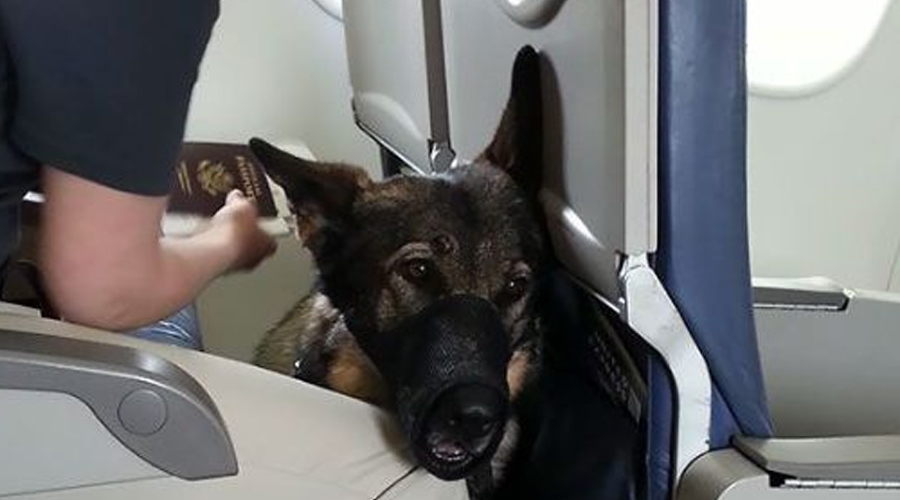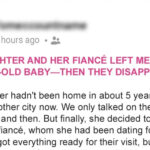It was just supposed to be a quick flight.
Window seat, noise-canceling headphones, maybe a nap if the turbulence played nice. I barely noticed the guy sliding into the row across from me, until I saw the muzzle—tight and secure—on the German Shepherd wedged awkwardly between his legs and the seat in front of him.
The dog’s eyes locked on mine immediately.
Not aggressive. Not nervous. Just… fixed. Like it knew something.
I looked away, brushed it off. Service dog, probably. Or military. Not my business. But every time I glanced over—every time—I met those same eyes. Like it was waiting for something from me.
About halfway through the flight, the man adjusted in his seat and something fell to the floor. A brown envelope—plain, sealed, unmarked. It slid halfway under my bag. I tapped his arm to hand it back, but he didn’t flinch.
Didn’t even blink.
I hesitated. Held it in my hand. It felt heavier than it looked. No label, no name. Just one faint word, scrawled in pencil across the flap.
My name.
Not my first. My full name. The one almost no one knew. The one I stopped using after everything that happened in ‘09.
I looked back at the dog. Still staring.
Muzzle or not, it gave this low whine. Almost… urgent.
That’s when I decided to tear the envelope open—and what I found inside made my stomach drop.
Because tucked between two thin sheets of paper was a Polaroid photo. An old one, creased at the edges. In it, a younger version of myself stood next to a woman whose face I hadn’t seen in years: Clara. My sister. She’d been missing for nearly a decade, presumed dead after she vanished without a trace during a hiking trip in the Rockies. Her disappearance had shattered our family, leaving us all adrift in grief and unanswered questions.
But here she was, smiling like nothing was wrong, her arm slung casually around my shoulder. The date written faintly on the back confirmed it: this picture was taken months after she disappeared.
My hands started shaking. I flipped the top sheet of paper over and read the typed message:
“Clara is alive. She needs your help. Trust the dog.”
Trust the dog? What kind of cryptic nonsense was this? My heart pounded as I glanced up again at the German Shepherd, who now seemed to be watching me with an intensity that bordered on human understanding. Its handler—the man sitting beside it—was still completely still, his head tilted forward slightly, as though he were asleep or… unconscious.
“Excuse me,” I whispered, leaning toward him. “Are you okay?”
No response. I reached out cautiously, tapping his shoulder again. His body swayed limply against the seatbelt, and dread pooled in my stomach. With trembling fingers, I pressed two digits to his neck, searching for a pulse. Nothing. He was gone.
Panic surged through me. Passengers nearby began to notice, murmuring nervously. Someone called for a flight attendant. But before anyone could intervene, the dog let out another low whine, then nudged its nose insistently against the envelope in my lap.
I stared at it, torn between disbelief and desperation. Was this some elaborate prank? Or worse—a trap? But the photograph was real. The handwriting matched hers. And deep down, buried beneath layers of pain and regret, I wanted to believe Clara might still be out there.
As paramedics boarded the plane upon landing, they pronounced the man dead of apparent natural causes. Authorities questioned me briefly about the envelope, but I kept quiet, clutching it tightly to my chest. Whatever this was, I needed answers.
Once we disembarked, the dog remained by my side, its leash somehow tangled around my wrist. When I tried to untangle it, the animal growled softly—not menacingly, but enough to make me freeze. The handler had clearly trained it well; despite the chaos, the dog stayed perfectly calm, its gaze never wavering from me.
By the time I stepped outside the airport, a black SUV pulled up beside us. A woman rolled down the window, her expression grim yet kind. “Get in,” she said simply. “We don’t have much time.”
Against every instinct screaming at me to run, I obeyed. The dog hopped into the backseat beside me, settling onto the floorboard as though it belonged there. As the car sped away, the woman introduced herself as Detective Marisol Vega. She explained that Clara had been involved in something dangerous—a covert operation targeting corrupt officials within the government. When things went south, she faked her death to protect herself and others.
“But why involve me now?” I asked, clutching the envelope like a lifeline.
“Because you’re her only family,” Vega replied. “And because whoever framed her for treason knows she’s alive. They’ll come after anyone connected to her—including you.”
Over the next few days, Vega filled me in on the details. Clara had left behind clues meant to lead me to her location, hidden in places only we would recognize. The dog, named Atlas, had been specially trained to guide me along the way. Its unwavering stare wasn’t suspicion—it was trust. Loyalty. Everything I’d failed to give my sister when she needed it most.
The journey took us across state lines, through abandoned warehouses and forgotten trails. Each clue brought me closer to Clara while forcing me to confront the guilt I’d carried since ’09. Back then, I’d blamed myself for not being there when she needed me. Now, I realized how wrong I’d been to shut her out entirely.
Finally, we reached an isolated cabin nestled deep in the woods. Inside, Clara waited, thinner than I remembered but alive. Alive! We embraced fiercely, tears streaming down both our faces. For the first time in years, I felt whole again.
But the reunion came with a cost. As we prepared to leave together, armed men surrounded the cabin. Betrayal stung bitterly when Vega revealed herself as part of the conspiracy. Yet true to form, Clara had anticipated this twist too. Using a decoy signal, she triggered alarms that distracted the attackers long enough for us to escape—with Atlas leading the charge.
In the end, justice prevailed. The evidence Clara had gathered exposed the corruption, bringing down key players in the scheme. Though scars remained, healing finally felt possible.
Back home weeks later, I sat on my porch with Clara and Atlas sprawled at our feet. Life had taught us hard lessons about trust, forgiveness, and second chances. Most importantly, it reminded me that love—whether from siblings or loyal companions—can guide us through even the darkest times.
So here’s the takeaway: Sometimes, the people (and animals) who seem to know more than they let on are trying to show you the way. Listen to them. Trust your instincts. And never give up hope, no matter how impossible things seem.
If you enjoyed this story, please share it with friends and hit that like button. Let’s spread a little faith and resilience today!


